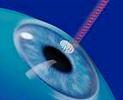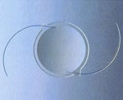EYE LASER
You may find details on eye laser and laser implantation here.
-
- 1) laser eye surgery (cornea methods):
There are two different cornea methods.
-
- Lasik
- Lasek (rarely used)
-
-
- a) LASIK Laser-in-situ Keratomileusis
Lasik (Laser in Situ Keratomileusis) means replacing the structure within the cornea layer by using laser technology. There have been 12 million ophthalmological treatments with this method since 1990. Current Lasik technology is able to treat 90% of optical disorders.-
- This treatment method applied by the most modern and the most sensitive techniques considered to be painless has become more and more popular in the world as it provides a quick recovery and wide areas of application. In general, the less optical disorder you have, the more successful treatment is. In practice, the Lasik technology is applied to cases with minor or medium amounts of myopia as well as minor amounts of hyperopia and astigmatism. Lasik treatment is an ambulatory treatment. Staying in hospital is not required.
-
- Tissue ablation lasts for 30 or 90 seconds. Due to a system monitoring eye movements, we are able to examine your eye at all times. When you move your eyes randomly, thousands of examinations can be done within a second thanks to laser beams.
-
Significant points in LASIK treatment:
-
-
-
- Results are highly sensitive and permanent.
- Correction of sight deficiency takes place in inner cornea.
- There is no pain before or after the surgery.
-
-
It has three different Lasik applications:
-
-
-
- Micro-ceratome standard lasik application (almost never used anymore)
- Laser ceratome and femto lasik (I-Lasik) application
- ReLex Smile application
-
-
-
-
-
-
- a1) Micro-ceratome standard lasik
-
-
-
Before the application, the doctor cleans the eyelid and then uses an eyelid holder in order to have a fixed eyelid.
This method includes ablation of a thin flap from the top surface of the cornea via the computer-controlled knife of micro-ceratome; until there is a very thin connection between the flap and the cornea. This old procedure will almost not anymore used in Turkey. Some cheap clinics still offer it. Please do avoid them.
-
- a) LASIK Laser-in-situ Keratomileusis
-
a2) Laser ceratome Intralase method, Femto Lasik
Femto lasik called femto second lasik, “Lasik laser” or “intra lasik” or “I-LASIK” is a new method in laser eye treatment for myopia, hypermetropia and astigmatism.
In femto lasik method, femto second laser is used in addition to excimer laser. So far, in laser lasik surgeries, a thin flap from the cornea has been opened backwards via ablation, with the use of micro-ceratome. In modern femto lasik technique, femto second laser replaces micro-ceratome and that makes it possible to have laser lasik eye treatment without the use of mechanical devices.
After laser ablation, the top flap of the cornea is opened backwards and the sight deficiency is corrected through an ablation of cornea layer with an excimer laser device, as in the case of laser lasik surgeries.
a3) ReLex Smile Lasik
The ReLEx smile treatment is the further development of femto-LASIK and allows a particularly safe and gentle correction of refractive error. The key advantage: With ReLEx smile we can laser your eyes without a “flap” and no longer have to open the cornea over a large area – like it at the LASIK is necessary. Inside the cornea, a special femtosecond laser prepares a thin, three-dimensional slice, which is taken from the cornea via only 2 mm access. This procedure protects the eye, the cornea remains stable and flap complications are excluded. This minimally invasive treatment is our first choice for correcting myopia, astigmatism and dry eyes. More Information you can please find here.


b) Lasek (Laser Epithelial Keratomileusis) (old method)
Lasek application is a method that has to be considered as a technique between PRK and LASİK.
It is applicable to those eyes with a very thin cornea that is impossible to treat and eyes with very low sight deficiency such as 4 dioptre myopia and astigmatism as well as 3.5 dioptre hypermetropia and astigmatism.
Unlike Lasik operations, it not the back but the front of the cornea that is treated. Similarly, a cornea flap is removed via a solution including alcohol and after the treatment, it is placed back. Here, it fixes itself to its original spot.
e) Supracor Lasik (against reading eyeglasses)
The SUPRACOR procedure is based upon the well-known, commonly used LASIK laser eye treatment for vision correction. The SUPRACOR laser procedure is quick, safe, and effective*.
The procedure can treat a wide range of presbyopic patients, and may also be suitable for patients who have previously undergone a LASIK procedure. The procedure provides excellent distance, intermediate and near vision, whilst maintaining a high quality of vision.
The SUPRACOR procedure is performed using a high-tech laser system called the TECHNOLAS Excimer Workstation which is made by a German company called Technolas Perfect Vision GmbH. This excimer laser is used to precisely reshape the cornea to restore near vision and simultaneously treat hyperopia or myopia, if necessary.
The treatment involves first creating a thin flap on the surface of the eye with either a femtosecond laser or a microkeratome. This upper layer or flap is then moved to one side to allow the surgeon access to the cornea. Then the surgeon uses the excimer laser to accurately reshape the cornea and treat the presbyopia.
For optimum safety, the excimer laser uses the state-of-the-art Advanced Control Eye-tracking (ACE) technology. Using iris recognition technology, this dynamic tracker continually tracks eye movements, rotation and pupil shift and simultanteously adjusts the laser beam to ensure the laser is accurately delivered during the entire procedure.
At the end of the procedure, the surgeon repositions the flap to its original position. This allows the eye to naturally heal.
The whole procedure takes only a few minutes.
2) Lens implantation method
Cornea application reaches to natural limits that must not be exceed in high sigh deficiency cases. In myopia, this starts at -10 dioptre and in case of hypermetropia, it starts at +4. This method is also used against presbyopia.
The method has two sections:
Intraocular lenses (Phakic OIL)
multifocal lenses in presbyopia or with combination in presbyopia
2a) Intraocular lenses
Inner eye lenses implanted into the eye
Sight deficiency in eyes with very high level of myopia or hypermetropia and that are not available for laser operation due to a very thin cornea layer can actually be corrected via FAKIK-IOL surgery.
Based on a lasik laser surgery for correcting possible cornea deficiencies, sight deficiencies such as myopia between 7 and 25 dioptre and a hypermetropia between 5 and 13 dioptre.


2a1) Area of application
FAKIK-IOL surgeries are applicable to those who are older than 18 and to patients suffering from glaucoma (high eye pressure), some retina deficiencies, cataract or glaucoma (ophthalmia). The decision on the applicability of this surgery can actually be made after a detailed examination where the degree of sight deficiency and growth of pupil in the dark and the exact shape of the cornea are identified.
2a2) Surgery
FAKIK-IOL surgery provides absolute results in patients with high level of myopia and hypermetropia. Only the best artificial eye lenses are used for these applications, in our hospital. Artificial lenses implanted onto the eye sustains its adaptation and optical features for a life-time. After surgery, it is not possible to detect this artificial lenses, even the patient’s himself does not perceive it as a foreign material in his eye.
2b) Multifocal – trifocal lenses in Presbyopia
Presbyopia adjustments, known as hypermetropia brought by old age where the eye loses its flexibility in adjusting the eye for close-range, are virtually made via these artificial lenses.
In multifocal lenses, concentric rings in various widths are “superimposed over each other” and thus various fields of vision and focal points are formed so that the eye chooses its unconscious and accurate field vision.
Multifocal lenses have been available for a long time and recently, there have been significant improvements.

